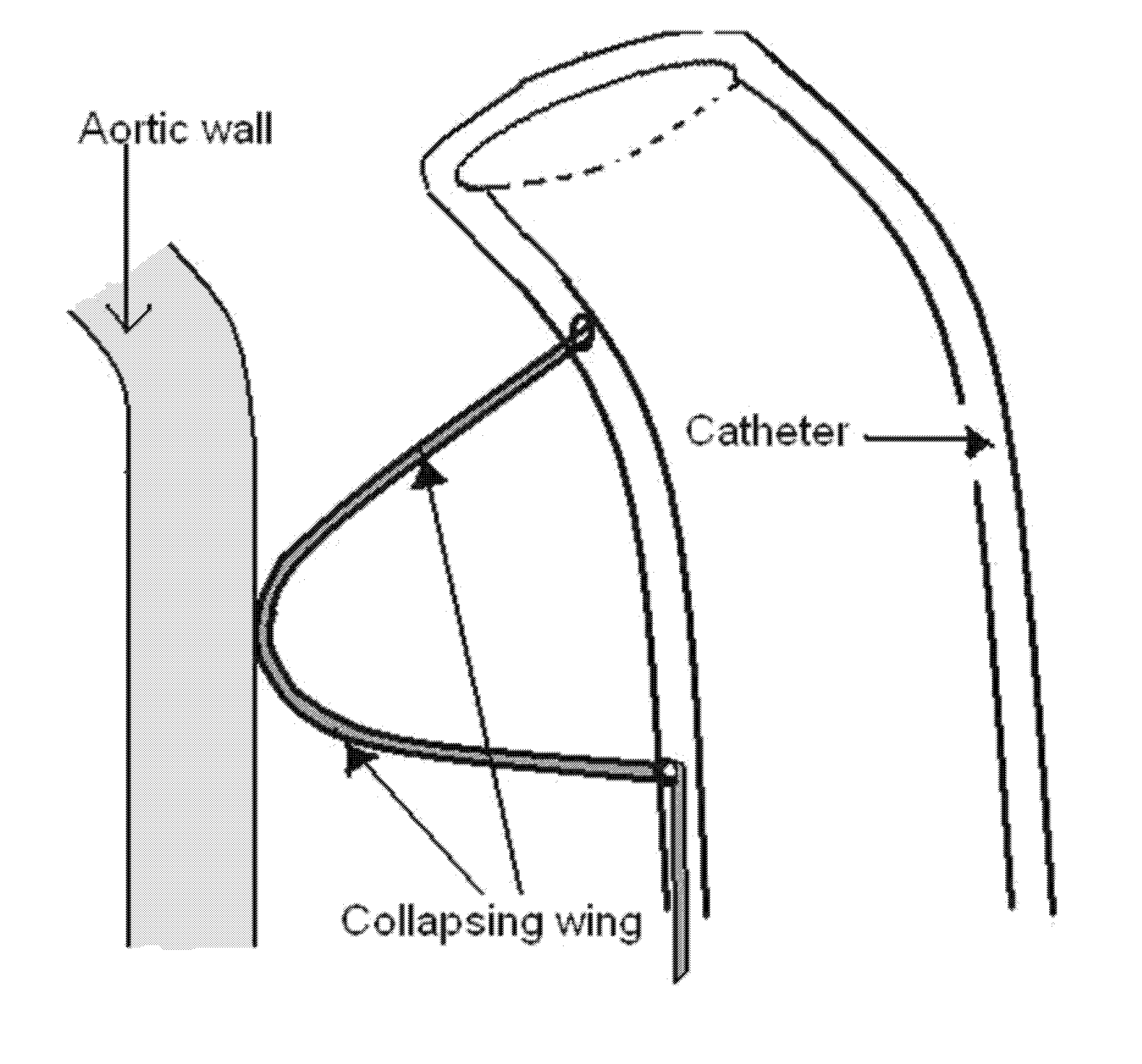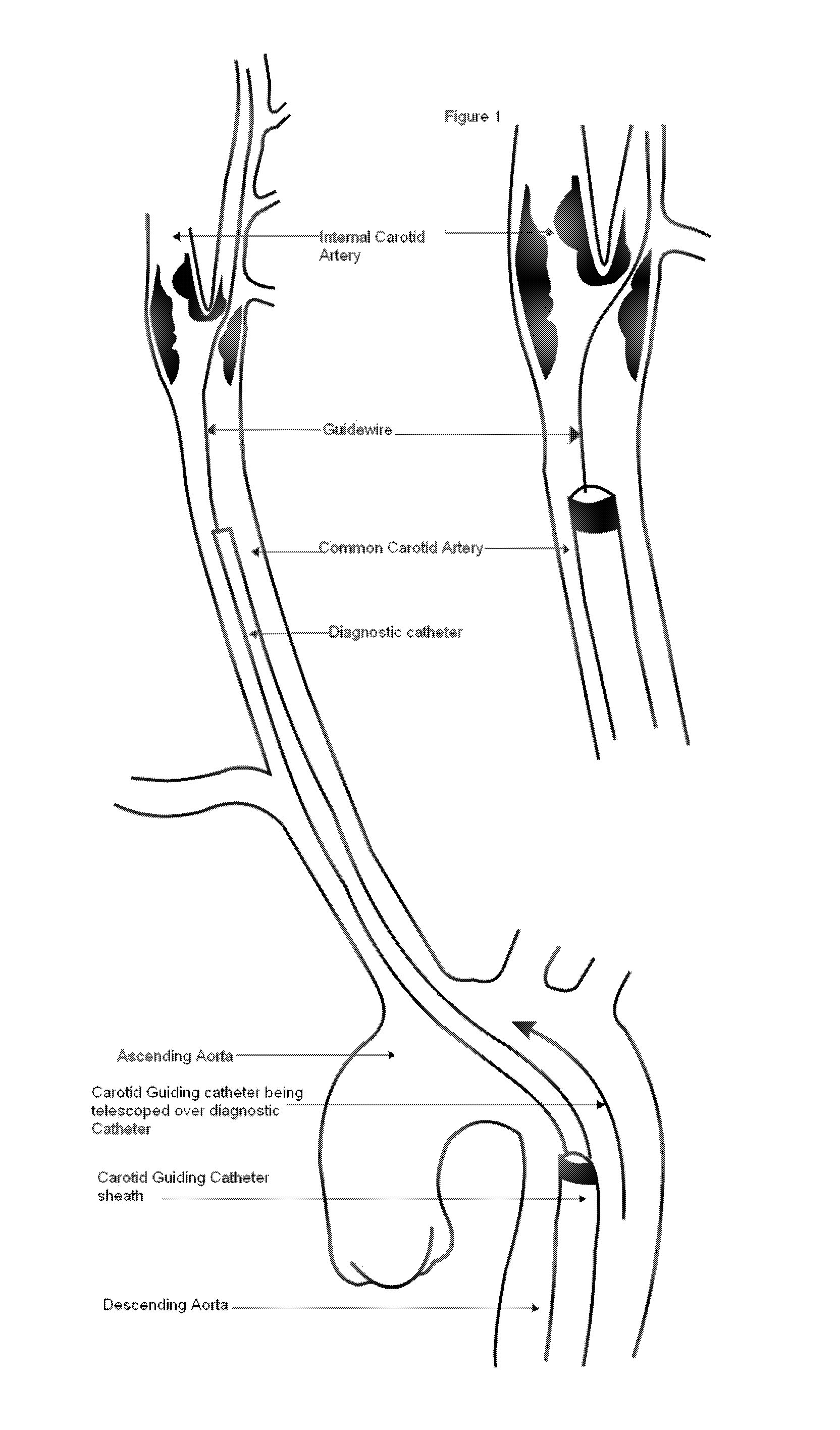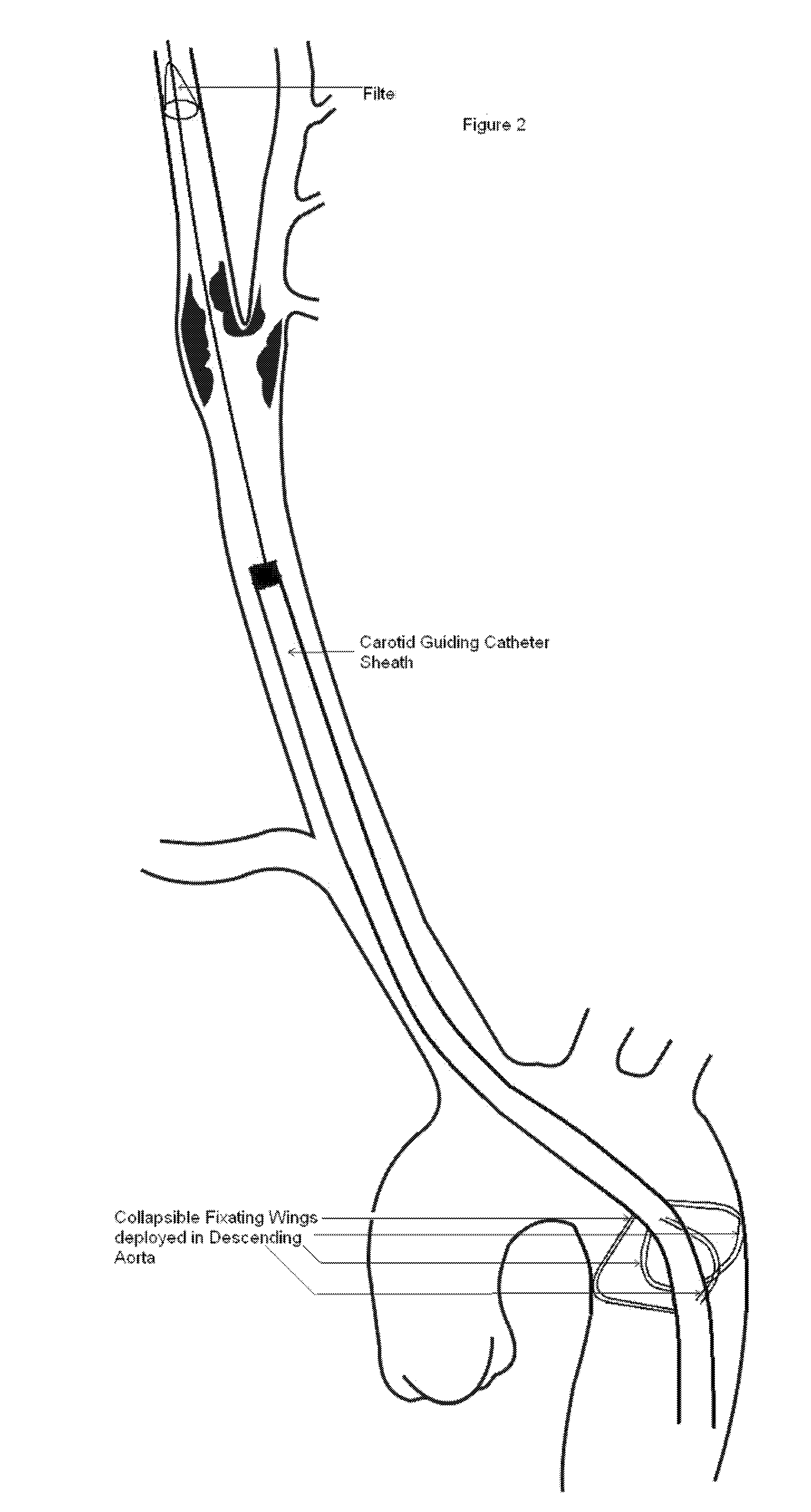Carotid guiding catheter (sheath) for carotid percutaneous intervention/stenting with internal fixation device to prevent migration of the Carotid guiding catheter (sheath)
Inactive Publication Date: 2010-08-12
SHARMA SANJIV
View PDF8 Cites 23 Cited by
- Summary
- Abstract
- Description
- Claims
- Application Information
AI Technical Summary
Benefits of technology
[0012]The present invention relates to a guiding catheter (sheath) that is specifically designed to facilitate the passage of therapeutic devices (embolic protection device, stent, retrieval sheath system) into the carotid artery. The present invention recognizes that the problem of backup support must be solved by making a fundamental change in the strategy the back up support is derived, by increasing the friction forces between the aorta and the guiding catheter (sheath).
[0013]The uniqueness of the guide catheter (sheath) of the present invention is the result of analysis of the factors determining the optimal support of a guide catheter within an aortic root complex and arranging these factors in a way to maximize backup support for distal advancement of a therapeutic device through the guide catheter. The catheter achieves a point of backup support against the wall of the descending or transverse aorta that is as close as possible to the ostium of the carotid artery without deriving any contact with the ascending aorta. This prevents any plaque to embolize from the ascending aorta that could predispose to occurrence of an cerebrovascular embolic event.
Problems solved by technology
In all carotid intervention procedures, it is absolutely crucial that the embolic protection device does not move during the passage of additional therapeutic devices like the balloon dilatation catheter, stent delivery catheter and the retrieval catheter; otherwise the risk of embolization through and past the embolic protection device increases substantially.
However, given the built up potential energy and torque forces in the guiding catheter (sheath), there is often a sudden distal movement (“jumping”) of the end of the guiding catheter (sheath) encountered, especially in stiff and calcified aortas.
resistance is encountered in the passage of the embolic protection device often leading to either unsuccessful delivery of the embolic protection device to the desired location (sufficiently distal to the lesion site), or to a recoil of the guiding catheter (sheath) from the carotid.
The lack of “backup” support occurs because the guiding catheter (sheath) derives its backup support only from the contact it makes with the descending or transverse aorta.
Because the surface area of contact between the secondary curve portion and the aortic wall is so small, the guiding catheter (sheath) is unstable and therefore easier to dislodge from its position against the aortic wall when resistive “pushback” forces are encountered during advancement of devices.
After the limit of this axial friction is overcome the guiding catheter (sheath) usually will recoil and buckle out of the carotid, endangering cerebral embolism.
Method used
the structure of the environmentally friendly knitted fabric provided by the present invention; figure 2 Flow chart of the yarn wrapping machine for environmentally friendly knitted fabrics and storage devices; image 3 Is the parameter map of the yarn covering machine
View moreImage
Smart Image Click on the blue labels to locate them in the text.
Smart ImageViewing Examples
Examples
Experimental program
Comparison scheme
Effect test
Embodiment Construction
[0021]One embodiment of the catheter of the present invention is shown above. Other modifications, changes and substitutions are intended in the foregoing disclosure and in some instances some features of the invention will be employed without a corresponding use of other features. Accordingly, it is appropriate that the claims be construed broadly and in a manner consistent with the scope of the invention.
the structure of the environmentally friendly knitted fabric provided by the present invention; figure 2 Flow chart of the yarn wrapping machine for environmentally friendly knitted fabrics and storage devices; image 3 Is the parameter map of the yarn covering machine
Login to View More PUM
 Login to View More
Login to View More Abstract
A carotid intervention guiding catheter (sheath) including a central lumen adapted to receive a therapeutic catheter and stent delivery catheter. The catheter includes a soft tip adapted to lodge in the common carotid artery. The distal body of the guiding catheter includes a mechanism to fixate the catheter to the wall of the aorta to prevent sliding of the guiding catheter in and out of the common carotid artery. The mechanism is a collapsible set of wings that come out of the wall of the catheter using a mechanical switch outside the body that deploys the wings and fixate the catheter to the wall of the descending or transverse aorta. The same mechanical switch allows the wings to collapse into the wall of the guiding catheter and allow the catheter to be retrieved out of the body.
Description
BACKGROUND OF THE INVENTION[0001]This invention provides a stable supporting catheter device for accessing the common carotid artery for performance of carotid intervention, including deployment of distal protection devices and stents into the carotid artery, without the likelihood of the guiding catheter prolapsing out of the common carotid ostium, especially if resistance is encountered in the delivery of the distal embolic protection device or stent into the carotid.[0002]Catheters are used for injecting dye in the performance of carotid angiography for diagnosis; and carotid intervention in order to treat a stenotic lesion in the carotid artery. In these techniques the distal end of a therapeutic catheter is introduced into the aorta by way of the femoral artery. The proximal end of the catheter is then manipulated so its distal end is inserted into the lumen of a selected carotid artery branching off from the aorta. A typical treatment procedure would involve initially insertin...
Claims
the structure of the environmentally friendly knitted fabric provided by the present invention; figure 2 Flow chart of the yarn wrapping machine for environmentally friendly knitted fabrics and storage devices; image 3 Is the parameter map of the yarn covering machine
Login to View More Application Information
Patent Timeline
 Login to View More
Login to View More IPC IPC(8): A61B17/00
CPCA61B17/3468A61M25/0662A61F2/95A61B2017/3484
Inventor SHARMA, SANJIV
Owner SHARMA SANJIV
Features
- R&D
- Intellectual Property
- Life Sciences
- Materials
- Tech Scout
Why Patsnap Eureka
- Unparalleled Data Quality
- Higher Quality Content
- 60% Fewer Hallucinations
Social media
Patsnap Eureka Blog
Learn More Browse by: Latest US Patents, China's latest patents, Technical Efficacy Thesaurus, Application Domain, Technology Topic, Popular Technical Reports.
© 2025 PatSnap. All rights reserved.Legal|Privacy policy|Modern Slavery Act Transparency Statement|Sitemap|About US| Contact US: help@patsnap.com



